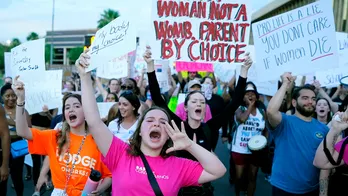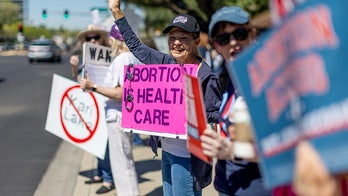
House Minority Leader John Boehner stands behind a copy of the health care bill Oct. 29 on Capitol Hill. (AP Photo)
Americans concerned that Congress may have forgotten the value of their tax dollars -- or in the case of health care reform, nearly a trillion dollars -- might want their lawmakers to rent the movie "Dave" this holiday weekend, and take a lesson in Cut the Fat 101.
Big-ticket items like the proposed government-run insurance plan and other aid programs have attracted the most heat in the debate so far. But there are a host of smaller programs that are sopping up federal dollars without a whole lot of public scrutiny.
And, they add up.
"There's definitely a lot of waste in it," said Erica Gordon, director of government affairs with Citizens Against Government Waste.
Dozens of grant programs, demonstration projects and new bureaucratic arms will be established under the proposed legislation. They target worthy goals like reducing obesity, training medical professionals, breaking through the language barrier in culturally diverse communities and improving maternal health. Some are considered preventive measures, aimed at reducing the country's long-term health care costs.
But government watchdog groups say that if lawmakers were so inclined, they could break out their paring knives and shave off a billion here, a billion there, and still have a robust bill -- only for less money.
"They're all good things. ... But in the end, (lawmakers) simply do sort of decline to make any tough choices," said Michael Tanner, senior fellow at the Cato Institute. "When confronted with one from Column A and Column B, they take both."
FoxNews.com took a look at some of these programs to provide a sampling of where the cost increases are coming from around the edges of health care reform. And -- who knows? -- maybe Washington will take a page from Hollywood, and go line-by-line over the spending items like Kevin Kline and his Cabinet in the finale of "Dave."
Demonstration Program to Promote Access for Medicare Beneficiaries With "Limited English Proficiency"
Section 1222 of the House-passed bill would empower the secretary of health and human services to award no fewer than 24 three-year grants for Medicare providers in communities where many people don't speak English. The money would go toward interpreter services to help break through the language barrier between the providers and those who need medical help.
The cost: $16 million a year. No grant could be over $500,000.
Grants for "Early Childhood Home Visitation Programs"
Section 2951 of the Senate bill would authorize the secretary to make grants to states and non-profits for early childhood visitation programs. The programs would be aimed at improving maternal and newborn health; preventing child injuries and abuse; improving school performance; reducing domestic violence; and improving "family economic self-sufficiency." Not all of those goals are health care-related, though, and are included in a section that asks states to conduct "needs assessments" examining issues like high-school dropout rates and unemployment.
The cost: $1.5 billion over five years. The program allows the grant recipients to go three years without submitting a performance report to the secretary.
Grants to Promote "Positive Health Behaviors and Outcomes"
Section 2530 in the House bill authorizes federal officials to award grants to promote healthy behavior in medically underserved areas. The goal would be to educate those communities about the risks associated with poor nutrition, tobacco use, lack of exercise and other health problems.
The cost: $30 million over five years.
"Healthy Teen Initiative" Program to Reduce Teen Pregnancy
Section 2526 of the House bill establishes a program that would provide grants for schools, non-profits and other groups for educational programs aimed at reducing teen pregnancy and the spread of sexually transmitted diseases.
The cost: $50 million annually over a period of five years.
Training for Dentists
Section 2215 of the House bill sets up a training program for oral health professionals. The program would allow the secretary to make grants or award contracts to entities that can develop and operate a professional program for dentists and other professionals would who work in the field.
The cost: $1.3 billion for that and other similar programs over five years. The bill does not break out how much of that money would go exclusively to the training program.
Wellness Program Grants
Section 112 of the House bill allows the labor and health secretaries to award grants to small businesses to cover 50 percent of costs associated with wellness programs. These programs could include services ranging from health screenings to counseling to online programs and deal with issues like obesity, stress management and depression.
Cost: Unknown. The section states that none of the grants, which can last up to three years, can exceed $50,000. But there's no cap on overall payouts. The language provides for "such sums as are necessary to carry out this section."
Payouts for Fence-Sitting Lawmakers
Sen. Mary Landrieu, D-La., who for weeks was publicly undecided on whether she would vote with her Democratic colleagues to bring up the health care bill for debate, won a hefty concession from Majority Leader Harry Reid before finally voting to proceed. The concession comes in a section that increases Medicaid subsidies for states recovering from a major disaster within the last seven years -- meaning, Louisiana.
The cost: Somewhere between $100 million and $300 million.
Patent Protection for Drug Companies
Section 7001 of the Senate bill protects manufacturers of biotechnology drugs, or biologics, from competition from generic brands for 12 years, which is more than the seven years recommended by the Obama administration.
Citizens Against Government Waste criticized this provision, saying it would increase costs to both taxpayers and consumers by limiting the amount of time the cheaper, generic brands are on the market -- though supporters of the measure argue that it helps drug companies make up the high costs of research and development.
Joshua Gordon, policy director with The Concord Coalition, counted the drug industry provision among the "extraneous" proposals included in the bills in order to win political support.
"It was done really to appease the pharmaceutical lobby and members of Congress who have strong pharmaceutical representation in their districts," Gordon said, counting the Louisiana disaster zone money in the same category.
Gordon and Tanner both said that if lawmakers put their minds to it, they could trim out tens of billions of dollars.
But they also said cutting down the grant programs and demonstration projects would not make a colossal difference in price -- since the bulk of the cost that the government assumes is for subsidies to low-and middle-income Americans to buy health insurance.
The Congressional Budget Office estimated that by 2019, 19 million people would be receiving subsidies worth $5,500 on average under the Senate bill. About 18 million would be receiving subsidies worth $6,800 under the House bill.
Gordon said there's not much the government can do to pare down that cost, because too few subsidies could discourage people from signing up for coverage.
"There is a danger in not providing enough subsidies," he said. And Gordon said specifically targeted programs like the one for early childhood home visitation can actually give some "bang for the buck."
Tanner, though, said the subsidies need to be decreased, because a large portion of the financial aid would be for people who can already afford health insurance.
"That's what makes it so expensive," Tanner said. "Unless you're willing to address that, there's no way to trim the cost significantly."
He added: "Could you get $50-60-70 billion out of it (without addressing subsidies)? Probably."




